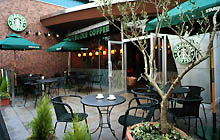 |
 |
 |
 |
 |
 |
|||||
 |
 |
 |
 |
| COMPETITION BREWING: Foreign Coffee Shops Give Boost to Japanese Market June 25, 1999  The new coffee chains offer customers a different atmosphere in which to enjoy their drinks. (Starbucks Coffee) With low price as a key attraction, foreign-owned coffee-shop chains are taking the Japanese market by storm. As consumers enjoy increased product variety and more shops to choose from, a "coffee war" between Japanese, American, and Italian competitors is unfolding with Tokyo shopping streets and business districts as the battlegrounds. Flavor, Price, and Atmosphere the Keys To keep the shops smelling fresh and the beans in good condition, no smoking is allowed inside Starbucks coffee houses. The darkly roasted, full-bodied coffees are the main attraction. Price is another draw, however, with a single espresso selling for 250 yen (2.08 U.S. dollars at 120 yen to the dollar) and a short caffe latte (a small serving of espresso in steamed milk) for 280 yen (2.33 dollars). Also on the menu are plenty of food items, including sandwiches and salads. Full-sized Starbucks locations are designed as warm, welcoming places to drink coffee, with natural wood decor and glass fronts that create a bright atmosphere. Many stores also feature terrace seating outside. Inside, the array of merchandise lined up on the shelves includes freshly ground beans as well as T-shirts, mugs, and other goods emblazoned with the company's siren logo. Even at coffee shops outfitted only with stand-up counters, a cup of coffee in Japan usually sells for around 200 yen (1.67 dollars). Starbucks has built its business on the coffee drinkers willing to spend just a little more to enjoy excellent coffee in a first-class setting--and there are plenty consumers that fit this description. In just three years, the number of Starbucks locations in Japan has grown to more than 50. The success of the first foreign entrant into the Japanese coffee-shop scene has not gone unnoticed. The "coffee war" is now heating up, with other foreign-owned chains jumping into the fray one after another. These include Tully's Coffee and Seattle's Best Coffee, both of the United States, and Segafredo Zanetti, Italy's largest coffee-shop chain. Homegrown Stores Also Going Upscale The battle zone is now expanding beyond bustling central Tokyo neighborhoods such as Ikebukuro, Shinjuku, and Harajuku. Upscale coffee houses are now cropping up across the greater Tokyo metropolitan area and in other cities across the country. Though the escalating "coffee war" presents a challenge to Japanese coffee shops, booming competition means more choice, giving consumers something to feel perky about.  Edited
by Japan Echo Inc. based on domestic Japanese news sources. Articles presented
here are offered for reference purposes and do not necessarily represent
the policy or views of the Japanese Government. Edited
by Japan Echo Inc. based on domestic Japanese news sources. Articles presented
here are offered for reference purposes and do not necessarily represent
the policy or views of the Japanese Government.
|

